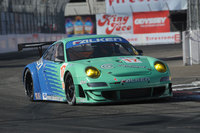In Their Own Words: Team Falken Tire
 |
Braselton, November 17, 2009: Tires are a pivotal component for any successful auto racing team - just ask Team Falken Tire motorsport supervisor Kevin Jones, tire engineer Yoshi Yasuda, team manager Rod Everett and driver Bryan Sellers. Each played a critical role in the team’s debut this year of its Porsche 911 GT3 RSR in the American Le Mans Series’ GT2 class, where Sellers and Dominic Cicero posted a best result of eighth at the season-ending Monterey Sports Car Championships presented by Patrón.
How does racing in the American Le Man Series advance Falken’s tire development?
Racing in this series not only allows Falken to develop a competitive tire for the American Le Mans Series but we can apply the knowledge learned here to our motorsports programs worldwide. Not only does the American Le Mans Series allow us to see how our tires perform in extreme conditions but we can compare our performance against the other top tire manufacturers in the world. Being that the Series is both an endurance and sprint race series at the same time, it not only makes the tire faster but forces tire development to become faster. - Yoshi Yasuda
Team Falken raced at three races all with very different characteristics this past season. What was it like for your team and your tires?
The American Le Mans Series has such a wide variety of track surfaces, some of which Falken has never raced on in our worldwide motorsports experience. Each venue we raced at this year had different pieces of information to offer.
Long Beach is a street course so it was necessary to race there in order to find out how Falken’s tire worked on the bumpy, varying surfaces. Unlike many of the other venues in the American Le Mans Series, you cannot rent out the Long Beach course and test there. Falken found some strong performing areas at this circuit but there is definitely always room for improvement.
Road Atlanta’s track surface is similar to many tracks but the high loads put on the tires and car because of the elevation changes at this track create an all-new situation to prepare for. Combine that with the very long, high-speed back straight and it makes an interesting track to develop a tire for. This year’s Petit Le Mans also provided heavy rain which was a good experience for Team Falken who had the fastest time in the wet during most of the downpour.
Mazda Raceway Laguna Seca is a very smooth, low-grip circuit which allowed us to evaluate how our tires operate on one of the premier race tracks in the world. This event was also important to us because of it being the season finale. We knew all of the other teams and manufacturers would be going for the best possible result, more so than usual, and we wanted to see how we compared. - Bryan Sellers
After each race, do you conduct a post-race inspection of the tires?
Each tire is carefully inspected by Falken’s tire engineer from Japan after every session, whether we are at a test or a race. He carefully inspects the wear characteristics of the tire to check for inconsistency. Select tires are dissected to further inspect the condition of the tire and to help gain knowledge of exactly how the tire is performing in order to apply this knowledge to future tire development. - Kevin Jones
Can you explain the “sweet spot” that you have discovered via open communication between drivers, team and car?
The “sweet spot” refers to a specific range in the car setup where the Porsche 911 GT3 RSR performs best with our tires. In this area, our drivers developed an ultra-sensitive feel to how different tire constructions and compounds performed under various conditions. This “sweet spot” allows for driver feedback to both the chassis and tire engineer to be quick and precise.
During the off-season, Team Falken is hard at work preparing to campaign a full American Le Mans Series season in 2010. Improvements to the tires are being made and every aspect of the program will be analyzed, criticized and evaluated in order to gain maximum performance for 2010.


